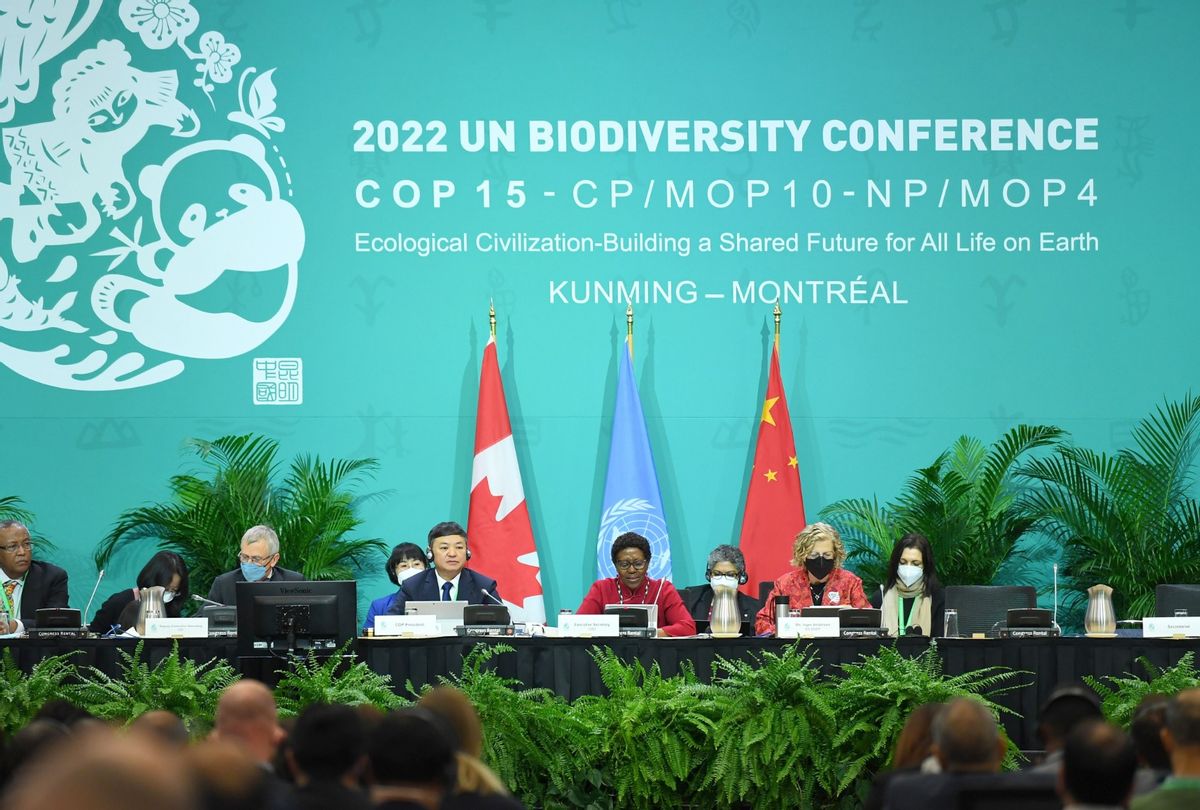Last week I flew from San Francisco to Montreal for a meeting of the most important global body trying to protect the planet's biodiversity. Before taking off on my Air Canada flight I wondered how the greenhouse gases coming from our airplane might, perhaps, impact the biodiversity many of us were headed to find out how to protect. I popped my head into the cockpit and asked the pilot if he'd be recording the greenhouse gas emissions from the fossil fuels that would power our aircraft across North America. He said no, but that "someone in corporate would be tracking them." We took off, and as we flew through the clear blue skies above the northern Great Plains, I thought about what the diversity of plant and animal species down there on Earth has to do with the greenhouse gases that our Airbus A220 was spewing from its two engines up here at 32,000 feet.
Many of the some 200 other people on the plane were heading to the same place I was — the Convention on Biological Diversity (COP 15), where the world would gather to try to slow the wipeout of biodiversity on the planet.
The greenhouse gas contribution of my one flight to Montreal, though tiny compared to what was released on a thousand or so flights that day and every day, is surely contributing to the biodiversity wipeout, for the turmoil in the atmosphere caused by greenhouse gases is one of the leading causes of biodiversity loss. But just as the pilot did not seem to be aware of the airplane's emissions, many journalists often don't make the connection between those emissions and biodiversity. The interplay between the disruptive effect of greenhouse gases in the atmosphere — including those from my fossil fuel–burning airplane — and the conditions for all living organisms on the Earth far below is a feedback loop that is often missing from journalism about climate change or biodiversity. Climate change is a biodiversity story, and biodiversity is a climate story.
The U.N.'s climate conference, COP 27, is already fading from the news, and here comes the U.N.'s COP 15 — the 15th Conference of the Parties (thus, COP 15) to the Convention on Biological Diversity. In fact, there's a story hidden in those two numbers: 15 and 27. The agreements were birthed at the same time — in Rio de Janeiro at the so-called Earth Summit in 1992. From the Earth Summit was born the United Nations Framework Convention on Climate Change, which has been leading the charge on climate change ever since; and the Convention on Biological Diversity, which is where some 10,000 delegates, scientists, representatives of NGOs and journalists converge on Montreal for two weeks in the depths of December (the number of attendees is about a quarter of those who were present at the climate conference last month). For the most part, the two events have been decoupled by the media as if they're reflecting concerns about two unrelated issues. But the two issues, and efforts to respond to them, are inextricably linked.
A million species are threatened with extinction, and we are losing a tropical primary forest the size of a soccer field every six seconds — just a couple of the statistics that are animating this gathering. One major contributor to those losses is climate change — the multiple ways in which rising temperatures, drought and land-use changes spurred by those phenomena are triggering major die-offs of animal and plant species. The loss of biodiversity also weakens our ability to withstand the impacts of climate change, for it's been found repeatedly that more biodiverse landscapes are more capable of withstanding climatic changes than monocultures or denuded lands.
That is a theme being hammered at here in Montreal. On Friday, the International Union for Conservation of Nature, considered the premier scientific arbiter of threatened species, held a press conference and issued an alarming press release with its latest findings: Some 42,000 species of plants and animals are threatened with imminent extinction (as distinguished from the million whose extinction is less imminent but on the horizon). Among those are almost 9% of marine organisms, victims of rising ocean temperatures and populations of oxygen-hungry algae that are increasing partly because of those rising temperatures.
A main issue on the table here is the subsidies paid by governments to industries whose activities decimate ecosystems. The United Nations identifies hundreds of billions of dollars in yearly subsidies that contribute to undermining biodiverse ecosystems — which in the U.S. can take the form of subsidies to industrial agriculture, housing developments, transit projects and many others. (Here's a handy list of what the U.N. calls "perverse incentives," subsidies that contribute to the erosion of ecosystems and to threatening animal and plant populations). Top of the list is agriculture, most of which consists of large-scale farming operations that make heavy use of pesticides that kill off many beneficial insects — and contribute to erosion, water pollution and deforestation; and half a trillion dollars globally in subsidies goes to the fossil fuel industry, which is wreaking havoc on the Earth's ecological balance. There's also a push here for a ban on single-use plastics — which clog waterways and often end up in the stomachs of seabirds and marine mammals.
The Convention on Biological Diversity has been signed and ratified by 196 countries. The United States — which signed the CBD in 1993 but has yet to ratify it, due largely to Republican opposition in the Senate — is not among them. But the issues on the table here for global action have their own versions underway in the U.S., including a proposal to ban single-use plastics worldwide; to reduce the use of toxic pesticides, which have devastating impacts on the ecosystems in agricultural areas; and to consider more ecologically sound methods for restoring lands that have been mined.
Last week the Society for Ecological Restoration released the first-ever set of protocols for remediation of mining activities — a set of principles relevant to any journalism in areas where mining is being pursued. The SER has also been pushing to ensure that offsetting, which is being pursued in the biodiversity realm as it is in the climate realm, does not become "just another way to stop pollution in one place in order to do it somewhere else." This is rich terrain for journalistic investigation: to check whether one's local biodiversity-rich wetland is being preserved while another one nearby is being polluted or transformed into industrial centers, houses, freeways or farms.
The U.S. has observer status here; the Biden administration sent a top State Department official, Monica Medina, with deep experience in international environmental negotiations, as its emissary to represent the United States' position through allies in Europe and Asia. It is not yet clear how the U.S. will wield its influence — even despite its lack of official representation — on the hot-button questions of a plastic ban or a reduction in pesticide use, issues that are also highly relevant to local communities across the United States.
For journalists, reporting on biodiversity is different from climate change in one fundamental way. It is, unlike climate, a zero sum. To slow the rate of climate change, there is one clear response: Reduce the emissions of greenhouse gases in one place and it has the effect of subtracting that atmospheric burden across the planet; conversely, increasing the amount of intact forest ecosystem acreage will reduce the atmospheric carbon dioxide load, benefiting everyone. Species loss is in many ways more complicated: You can't reduce biodiversity loss in one place and necessarily expect it to have impacts somewhere else. A biodiverse rainforest in Costa Rica, for example, may be able to withstand the whipsawing impacts of a changing climate, but that resilience may not translate to the climatic disruptions in, say, Florida or Pennsylvania or California. For resilience, you need biodiverse landscapes in the places where ecological traumas are occurring, which makes them the ultimate local story.




Shares